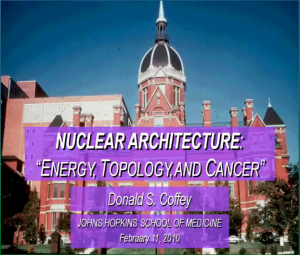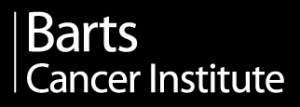February 11
2010
Biodesign Auditorium
727 E. Tyler St. Tempe
AZ 85287
Donald Coffey Well this is an amazing conference because this mix is a group of people you don’t normally get together. That is physicists, mathematicians, people who work in evolution, space, and outer solar systems and things. So, its just wonderful to hear all this talent come together and wrestle with the question of how can we get through and make a difference on cancer.
Pauline Davies Have you learned anything?
Donald Coffey Oh, absolutely! What’s come out of this, is by hearing people who are experts on how life can exist under very extreme conditions and understanding how the cell is organized, we are hearing all sorts of amazing things because the way you tell a cancer cell is that the cell is out of shape. Now obviously it has to be growing and this. But you can just look at an individual cell and tell it’s a cancer cell, like a pap smear.
Pauline Davies We don’t know why it’s out of shape?
Donald Coffey No, what we found is there’s a little a little skeleton inside, called a cytoskeleton that means a cell skeleton. And that structure is out of shape, so it makes the building out of shape. Like changing the beams in the building, so the building is out of shape. Then we found out that the cancer cell is actually capable of crawling and moving, so it actually crawls through people, called metastatic, it’s malignant and it invades things. So, when a bunch of cells grow its called a tumor and many women have lumps in their breasts and men have lumps in their prostate. About 90 percent of these are benign that means that they won’t bother you. But the others are malignant. Now the difference is that the benign ones grow like your fist, they grow as a little contained structure. So you can take those out like you sort of to take a tangerine out of a tangerine peel. So they easily have surgically. But if they look like your hand, they look like a crab, they are invading the normal tissue, they are not round and compacted, so the word for cancer from the zodiac was already here years before the disease was really recognized. So, in essence we are trying to find out why they spread, why they invade like this. But a tumor just means that its an abnormal growth; cancer means that its malignant. Then when pieces of this break off, they are metastatic, they go to other organs and cause trouble.
Pauline Davies We have been hearing a lot about the extra cellular matrix and how important that is. What do you make of all that?
Donald Coffey Well what happens is cells are sort of like coke cans, if you stack them up—that’s normal; but if you get a big stack that’s a tumor growth its abnormal accumulation. But if they are out of shape, as we said, then that is cancer. And what happens is they break loose from the plane they are sitting on. So imagine that you had a table, like a desk, and you had a can sitting on it. The table would be the extra cellular matrix and the can would sit on there and it is sort of locked in place. Now what happens normally is if that can comes off of that table, the cell is automatically programmed to self-detonate and kill itself, and that is called apoptosis like. But in a cancer cell, when they come off they keep growing. So they can spread to other spots. So the extra cellular matrix and how it talks and keeping the cell where it belongs, in the chest, in the brain, in the prostate, is very important. So here at this meeting, all sorts of experts in breast and prostate and a lot of scientists and people who understand a lot about how life is formed and how its controlled and how they are speaking together. This is a great meeting; lots of great ideas are coming out of it. I am fifty years in the field of cancer research at John Hopkins, so I’m up the ladder to say the least, and at least two-thirds of these people I have not meet before. Usually, when I go to a meeting I know everybody in the room. Here, there are all sorts of different disciplines; it’s really an exciting meeting.




